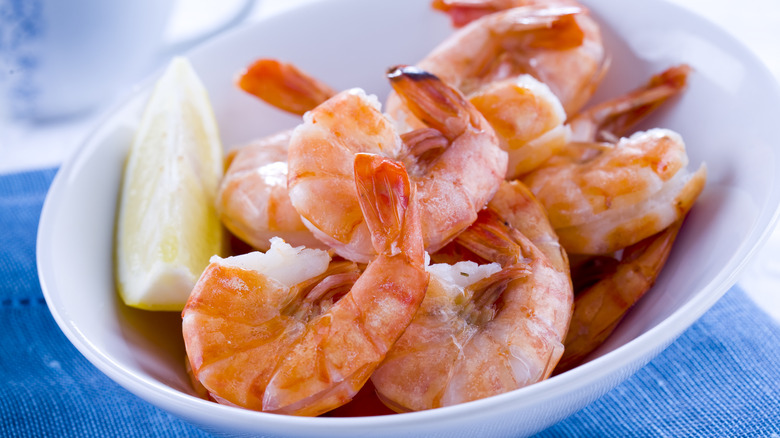The Reason Shrimp Changes Color As It Cooks
Shrimp is popular — maybe more popular than you realize. It frequently sits at the top of America's list of most consumed seafood by a comfortable margin and is a staple of so many different cuisines it would take a long time to list them all. It would be fair to describe it as one of the dominant global protein sources.
But even if you've cooked with shrimp, there might be things you don't know about it. Is that vein on their backs really excrement? (Not really, although it's not exactly pleasant.) Do you need to clean shrimp? (No, it's fine.) And hey, here's one you might not even have thought about: Why does it turn pink when you cook it?
The answer, it turns out, is due to the complex interactions of proteins in crustaceans' shells. The explanation gets a little technical, but the short version is this: Heat causes certain compounds to be released from crustacean shells, changing their color (and the color of the flesh within them).
Cooking shrimp releases a bright red protein
If you've ever seen uncooked shrimp, you know the natural state of their flesh is more of a translucent grayish hue. Their shells, meanwhile, tend to be more blue-green (this is especially visible in the case of lobsters and crabs). So how in the world do we get to red from there?
Those shells actually contain a protein called astaxanthin. Other fish have this, too, but with crustaceans, it's specifically in their shells. Astaxanthin is a carotenoid (the same thing you find in carrots), meaning it absorbs blue light and appears to us as red, orange, or yellow. But in crustacean shells, astaxanthin is bound by a protein called crustacyanin, which affects its ability to absorb light.
When you cook these crustaceans, though, it separates the crustacyanin from the astaxanthin, and the latter's bright red colors suddenly come alive. The flesh of a shrimp still isn't pink, though; that's pigment leeching from the shells into the shrimp itself.
This same process is why flamingos are pink
It's also important to note that, as mentioned, this doesn't just apply to shrimp; this same process is present in pretty much all crustaceans. It's the reason lobsters turn that distinctive bright red when cooked, as do crabs.
This same principle is also why flamingos are pink. Flamingos have naturally white feathers, but they also eat a ton of shrimp, and the carotenoids in both those and the algae that make up the rest of their diet release during digestion as the crustacyanin in their food dissolves. This, in turn, makes their feathers pink — much as a person who eats too many carrots will find their skin developing an orange hue.
Even if your skin isn't going to turn pink from eating shrimp, it's cool to know why the color change happens at all. So next time you make shrimp scampi, you'll be totally aware of what's going on.


